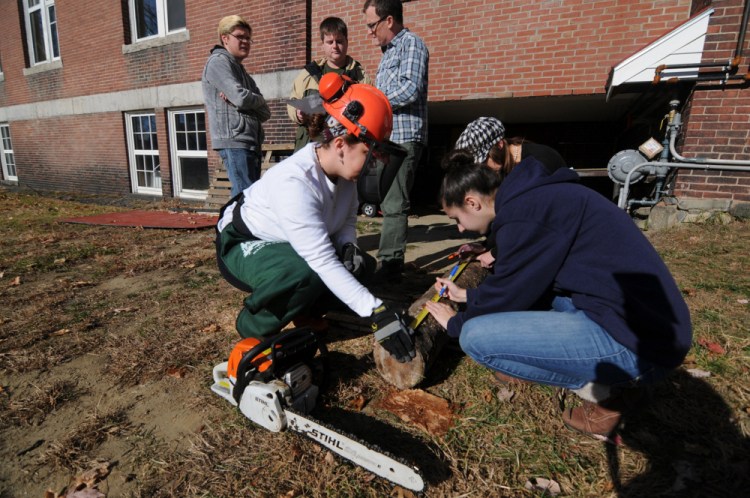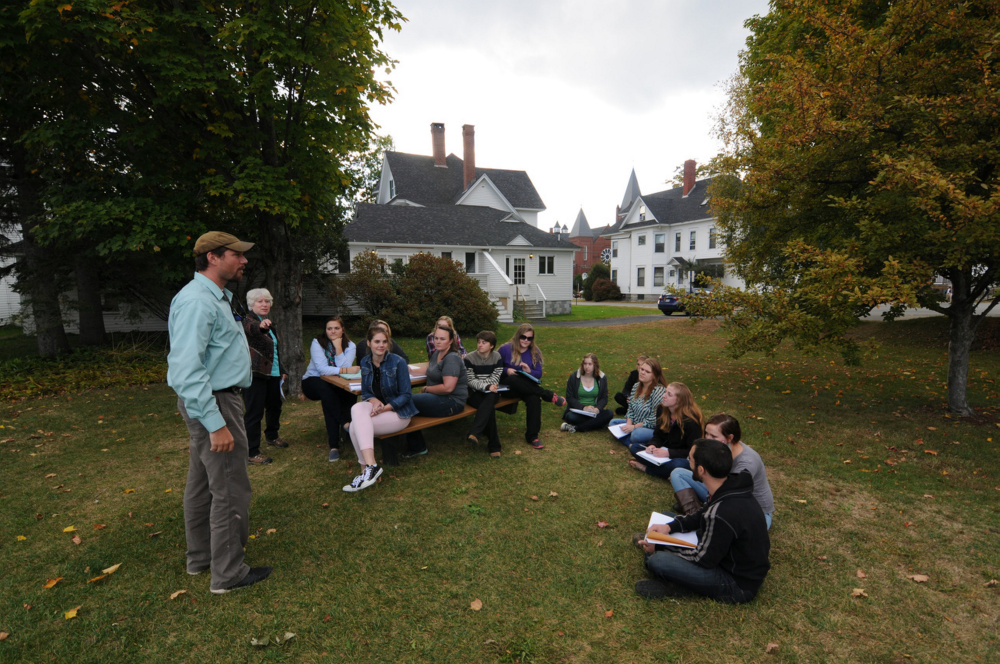FARMINGTON — Mud kitchens, willow tree tunnels and raised garden beds are several of the ideas University of Maine at Farmington students have planned to incorporate into the nature-based play area they are developing for the university’s early childhood education program.
The proposed play area is a collaborative project between students in early childhood education professor Patti Bailie’s Environments for Young Children course and others in geography professor Matt McCourt’s Land Usage course. The design for the play area will be completed before the end of fall. The play area is planned to be built at the Sweatt-Winter laboratory school on campus once funding is secured.
“There is evidence that some of children’s health and social issues may be linked to the amount and quality of time they spend in the natural world,” Bailie said. “Studies have shown that children’s experiences in the natural world have a positive effect on their attitudes, behaviors and environmental awareness.”
Together the students are working with landscape architect Sashie Misner, of Maine-based Mitchell and Associates, and UMF facilities management director Jeff McKay to develop the final design and construction plans for the outdoor play area, which will use all-natural building elements and activities. The play area is for children ages 3 to 5.
Bailie’s students are coming up with the components of the play area that the children themselves will interact with. From slides built into hills, rain buckets and water features or an all-natural amphitheater, the possible elements of the finished play area are vast.
“With this type of a play area, you can integrate a lot of different things in it,” Bailie said.
Students from McCourt’s land usage class have conducted the site analysis of where the play area will go outside the Sweatt-Winter building on campus. To find the best spot for the play area to be built, they considered factors such as light, drainage and environmental impact. McCourt’s students also have started cutting trees to form several of the components of the play area.
Bailie, who has 22 years of experience in the field of nature-based education, said that the draw for giving children the opportunity to learn in a natural environment are the numerous ways it allows a child to develop.
“You can provide all the different developmental goals of early childhood through a nature-based program,” Bailie said. “They’re doing the things that you want them to do developmentally, but they are doing them in an outdoor environment.”
At the Sweatt-Winter laboratory school, UMF early childhood education students spend a minimum of eight hours per week with children at the school’s day care and after-school programs for area children. Having the play area at the school will give students the ability to observe how children can develop physically, mentally and emotionally — all in an outdoor environment using natural elements.
By allowing children to have more open space and access to natural elements such as trees, they are more apt to partake in physical activity, Bailie said. Likewise, giving children less direction on how to use the natural play area makes them think creatively and develop relationships with other children in order to remain occupied.
“We’ve noticed when (children) have these opportunities (to be outside) … children use what we call loose parts — sticks and stumps and slices of trees — natural materials that afford a lot of different ways to use them. So they end up oftentimes showing improvement in problem solving skills, because they are figuring out how to build something with it. Their social development is also improving because they are working with others on a common goal,” Bailie said.
Another long-term goal of nature-based play areas is to teach children reasoning skills and environmental literacy.
Bailie said that if children spend time in a natural environment, they must regulate their behavior to reap the full benefits that playing in nature can provide. For instance, if the children are in a wooded area and they want to see the animals, they must be quiet or they will scare the creatures away.
“You’re not going to pick flowers if the butterflies need it for nectar. Or you’re not going to go off the trail, because you would be trampling things you don’t want to lose,” Bailie said. “The more that children are able to realize they are part of nature, not separate from it, they are going to grow up and be the people who help solve the (environmental) problems that we are having right now.”
Bailie expects the final plan for the play area to be completed later this month, and she hopes the play area will be built by the start of the 2016-2017 school year. The next step in the project’s process will be to secure funding for the construction of the play area. Bailie said organizers will be fundraising within the UMF and greater Farmington communities.
Lauren Abbate — 861-9252
Twitter: @Lauren_M_Abbate
Send questions/comments to the editors.




Success. Please wait for the page to reload. If the page does not reload within 5 seconds, please refresh the page.
Enter your email and password to access comments.
Hi, to comment on stories you must . This profile is in addition to your subscription and website login.
Already have a commenting profile? .
Invalid username/password.
Please check your email to confirm and complete your registration.
Only subscribers are eligible to post comments. Please subscribe or login first for digital access. Here’s why.
Use the form below to reset your password. When you've submitted your account email, we will send an email with a reset code.